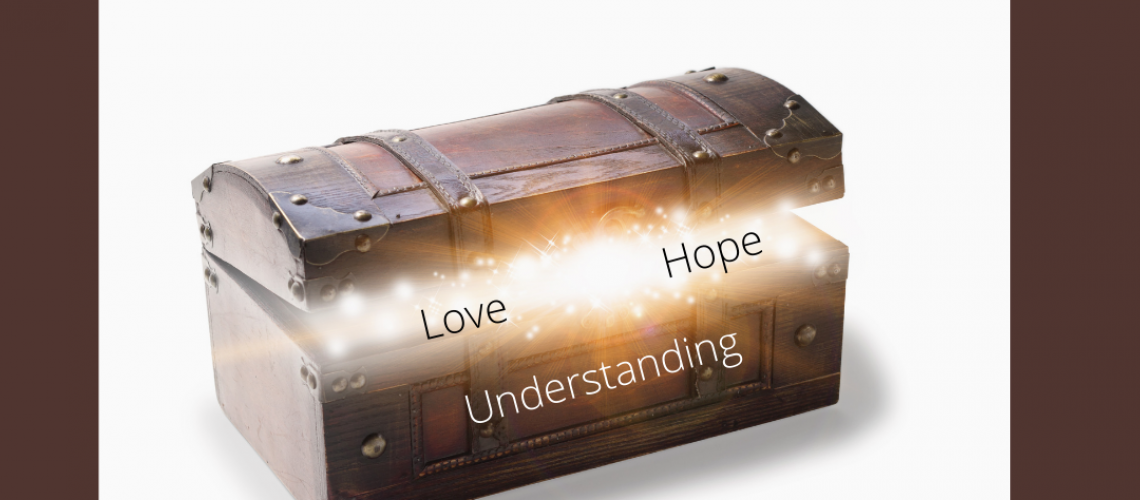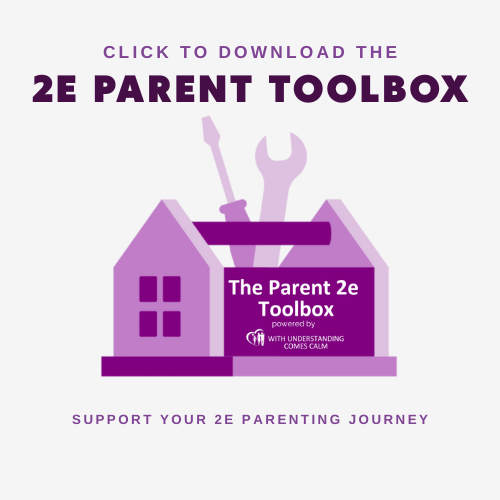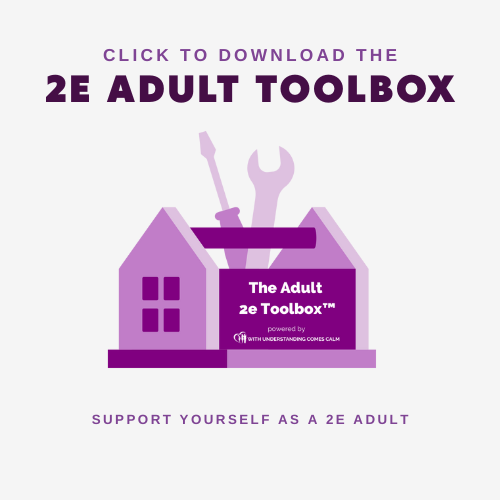There are certain apparent patterns with challenging twice exceptional behavior. Frequently the unwanted behavior we see in our twice exceptional children and students, or experience as 2e adults, is in response to an unseen trigger. The child or adult feels assaulted emotionally or from a sensory standpoint. They are overwhelmed, immediately thrown into fight or flight mode, and therefore their reaction appears over-the-top to the unassuming parent, teacher, fellow adult, or whomever happens to be in the vicinity. Usually the 2e child, responding to what feels like an onslaught, unwittingly unleashes another battle with someone who cannot perceive the first conflict, and an all-out war ensues. Rather than reaching down and finding empathy, love and understanding, oftentimes the ‘adult in the room’ acts out of their own emotions, feeling attacked without understanding why. It’s precisely those emotions – triggered by the other big emotions – that stand in the way of understanding, love and hope.
The invisibility of the initial trigger for the 2e person is what makes it so hard to respond with empathy and love. You’re about to start teaching your class, you want to transition to the bedtime routine, you are engaging in what you thought was an intellectual conversation about politics with your colleague – and suddenly WHAM! The formerly bright, interesting, fun person seemingly blows up out of nowhere. The cycle is this:
- The 2e person is triggered – likely their nervous system feels under attack;
- The 2e person’s thinking brain shuts off so the amygdala (our ‘fight or flight’ center in the brain) takes over to keep the person safe;
- The other person in the room, is caught off guard and experiences, surprise, shock and maybe even fear;
- That other person’s thinking brain shuts off and they enter into their own ‘fight or flight’ mode.
I think it’s pretty fair to say we’ve now got two saber tooth tigers facing off. This can’t be good.
On top of all that, if this is a parent-child situation, where the two players share genetics, there is the potential for heightened sensitivities on both sides. The child’s behavior might just be precisely the button that pushes the adult directly into fight or flight.
Let me propose a visual for both this cycle and for the solution. Imagine a cut away view of the ground where you can see the layers from the top down to the bottom where hidden treasure is buried. Whatever your reaction – yelling, lecturing, shaming, guilting, unleashing consequences – that’s sitting just on top of the ground. Below that are layers and layers of emotions – fear, anger, resentment, frustration, embarrassment, sadness, annoyance. Below that is what I’m calling the hidden treasure; love, understanding and hope.
Unfortunately, in order to get to the ‘good stuff,’ the treasure, to tap into that well of empathy, we have to find how to push through layers of challenging emotions that block our way. The job of the adult interacting with the 2e child (or 2e adult), is to get through and harness their own personal emotions, push them away, in order to appropriately and effectively respond to the wounded 2e person in front of them. This is not easy.
If, as I said earlier, the reacting adult is 2e, we know they are likely dealing with their own intensities and sensitivities. It’s not easy, but it is the responsibility of the other person to find a way to reach their empathic self, to find a way to not take the behavior personally and to soothe the pain that the 2e person is experiencing. Let’s flesh out the examples from above.
Teacher Response
You are a teacher, and you want to start your class. One of your 2e students unleashes their class clown persona in a disruptive way. Or perhaps, you’ve asked the students to put away their books or toys or stop conversations and settle down to start class and the 2e student simply won’t close his book. Or maybe you witness the 2e child picking a fight with another student or simply making rude, disrespectful comments to you as you are trying to settle everyone down to begin class. Your initial reaction is annoyance, maybe anger, perhaps you’ve ‘had enough’ of this student who seems to do this more often than not. Rather than entering into a power struggle, wonder to yourself – what could have happened? You might even think, “Gee, it’s just the beginning of the day, my gosh what will he be like in the afternoon?!”
Resist catastrophizing, resist assumptions – this child may come from a highly emotional family and there might have been challenges this morning. This child may have overheard someone say something mean about him (this happens all too often in a 2e child’s life). In order to avoid an all-out power struggle, someone has to lay down the weapons; that someone is the adult. Try saying something diffusing like, “You don’t seem like yourself today, would you like to go get a drink of water or see the counselor and come back when you are ready?” Or, privately say, “I can see it’s been a hard morning, what do you need? What can I do for you?” This extra two minutes just might save you ten or more minutes of power struggles and increased interventions. During a calm moment, take the time to check in with this student. Ask if they are okay or if they need to talk to someone. Reassure the student you know it doesn’t feel good to be angry and you would like to help him feel better. This will establish a personal connection, help the student to feel safe and help you establish your role as being on the same team rather than on the other side of a battle.
Parent Response
It’s time to transition to bedtime. This is precisely when 2e kids ‘wake up.’ Why is that? Why do so many parents share with me that just when they are starting the bedtime routine, that is when their 2e child wants to talk, sing, dance, run around or just be with a parent? 2e kids keep emotions safely tucked away as much as they can. We know what happens when they unleash those big feelings – and by the way, they are trying to keep them under wraps in public. So, when it’s wind down time, it’s almost like the internal cabinet holding their emotions, is suddenly unlocked and with an enormous WHOOSH! the energy is released.
Precisely at this time, parents of 2e kids are dying for their own downtime. They’ve worked hard, they have bills to pay, emails to answer, maybe they are even trying for stolen moments with a spouse or a friend. This is exactly the time they want to hang up their parenting hat, put up their feet and sigh with relief. Sorry. That’s not now. I promise that will come and likely sooner if you can find the energy to give some extra attention to your 2e child right now. The 2e child needs to feel validated somewhere. They need to feel seen and appreciated and even celebrated at some point in the day.
Does this mean an all-out dance party every night before bed? No way. But it does mean structuring up some time intentionally to allow your child to talk and for you to actively listen and empathize. Establish this as part of the bedtime routine; call it ‘Pillow Talk’ or ‘Cuddle Time.’ When you name it, it allows you to tell your child you want to make sure you have time for it. Ask what they want to do to wind down for bedtime. Talk about showering or bathing – if that is calming for him, perhaps reading or listening to a book, maybe hearing classical music and some established one-on-one time with a parent to just listen. These nighttime chats should be free from judgment, teaching and problem solving. The parent’s role is to listen. To validate. To absorb your child’s myriads of emotions.
When your child shares something hard – that they’re thinking about death, the environment, politics, or how someone was mean at school, or how the teacher said something insulting or just didn’t understand – this is the time to say “Wow, that sounds like it was hard to hear.” Or “Gee, that must not have felt very good.” Or “You are thinking about important things.” Avoid going into problem solving mode. Just make space for your child to reflect and share. If you learn something that seems to need adult intervention, consider emailing the teacher or other professional, to ask for a phone conversation. If you feel your emotions are triggered, wait until the morning before sending the email.
Download The 2e Parent Toolbox™
Adult Response
Gifted and 2e adults seek companionship and find most fulfillment when they are with others who share their passions, intellect and abilities. If you are a 2e adult hanging out with other 2e adults, likely conversations are deep, meaningful and sometimes difficult. 2e adults respond in bigger ways to what happens around them. The cycle listed above can happen in social and professional settings for the 2e adult. Perhaps you are frustrated at a professional or social event where people seem to only want to engage in small talk. Maybe you are having a conversation and you are shocked at someone’s political viewpoint or maybe you just have self-doubt about how this person perceives you. Maybe the challenge comes in the other direction where you find the adult you are talking to rude, annoying, frustrating, boastful, or a know-it-all.
In any case, in order to be your best self, you need to be aware of your own emotions. Why is this so bothersome to you? Is it really worth getting into a power struggle? If you think of the acrimonious conversation as a tug-of-war game, can you drop the rope? How can you get to your empathy place? How can you understand why the other person is behaving a certain way, reacting the way he is, or simply saying what he is saying? You do not have to be life-long friends with this person, but in order to save yourself the pain of your own intense emotions, it is immensely helpful to depersonalize and ensure that you do not make this conversation, about you more than is necessary. So many 2e adults find themselves challenged in the social arena because of a misunderstanding of the other person or feeling misunderstood. Undoubtedly this triggers emotions and memories from childhood when the 2e child felt socially awkward or misunderstood or just felt badly about themselves. In fact, as an adult, deep down they may be thinking – haven’t I already been through this? Why is this still a problem? Check your emotions. See if you can find understanding for the person with whom you are interacting and more importantly, for yourself.
When we allow emotions to inform our reactions to challenging situations – we set up conflict. Whether you think of it as a tug of war, a full-fledged battle or detonating a bomb, in order to diffuse the situation and solve the problem, we must set aside our egos, forego assumptions and enlist our wells of empathy, understanding and hope.

Author: Julie Skolnick
Julie Skolnick, M.A., J.D., is the Founder of With Understanding Comes Calm, LLC, through which she passionately guides parents of gifted and distractible children, mentors 2e adults, and collaborates with and advises educators and professionals on bringing out the best and raising self-esteem in their students and clients.




